Stacks Representation & Operations | Programming and Data Structures - Computer Science Engineering (CSE) PDF Download
| Table of contents |

|
| Introduction |

|
| Stack Representation |

|
| Algorithm for PUSH Operation |

|
| Algorithm for POP Operation |

|
Introduction
A stack is an Abstract Data Type (ADT) commonly used in programming languages. It is named "stack" because it mimics real-world stacks, such as a deck of cards or a pile of plates.
 Behavior of a Real-world Stack:
Behavior of a Real-world Stack:
- Allows operations at one end only.
- Examples include placing or removing a card or plate from the top of the stack.
Stack ADT Characteristics:
- All data operations are performed at one end only.
- At any given time, only the top element of the stack can be accessed.
LIFO (Last-in-First-Out) Structure:
- Stack follows the LIFO principle.
- LIFO stands for Last-in-First-out, meaning the element inserted last is accessed first.
Operations on a Stack:
- PUSH Operation:
Insertion operation in a stack.
Adds an element to the top of the stack. - POP Operation:
Removal operation in a stack.
Removes the top element from the stack.
Stack Representation
The following diagram depicts a stack and its operations −
A stack can be implemented by means of Array, Structure, Pointer, and Linked List. Stack can either be a fixed size one or it may have a sense of dynamic resizing. Here, we are going to implement stack using arrays, which makes it a fixed size stack implementation.
Basic Operations
Stack operations may involve initializing the stack, using it and then de-initializing it. Apart from these basic stuffs, a stack is used for the following two primary operations −
- push(): Pushing (storing) an element on the stack.
- pop(): Removing (accessing) an element from the stack.
1. Push Operation
The process of putting a new data element onto stack is known as a Push Operation. Push operation involves a series of steps:
- Step 1: Checks if the stack is full.
- Step 2: If the stack is full, produces an error and exit.
- Step 3: If the stack is not full, increments top to point next empty space.
- Step 4: Adds data element to the stack location, where top is pointing.
- Step 5: Returns success.
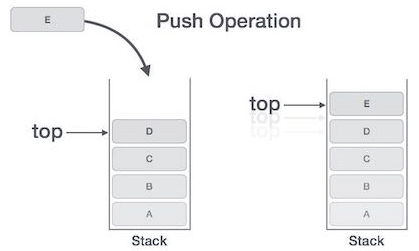
If the linked list is used to implement the stack, then in step 3, we need to allocate space dynamically.
Algorithm for PUSH Operation
A simple algorithm for Push operation can be derived as follows:
begin procedure push: stack, data
if stack is full
return null
endif
top ← top + 1
stack[top] ← data
end procedure
Implementation of this algorithm in C, is very easy. See the following code:
Example
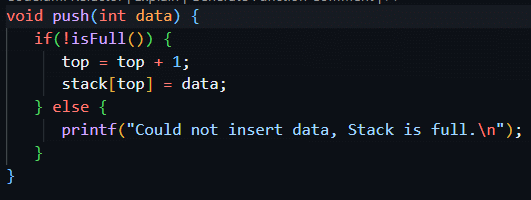
2. Pop Operation
Accessing the content while removing it from the stack, is known as a Pop Operation. In an array implementation of pop() operation, the data element is not actually removed, instead top is decremented to a lower position in the stack to point to the next value. But in linked-list implementation, pop() actually removes data element and deallocates memory space.
A Pop operation may involve the following steps:
- Step 1: Checks if the stack is empty.
- Step 2: If the stack is empty, produces an error and exit.
- Step 3: If the stack is not empty, accesses the data element at which top is pointing.
- Step 4: Decreases the value of top by 1.
- Step 5: Returns success.
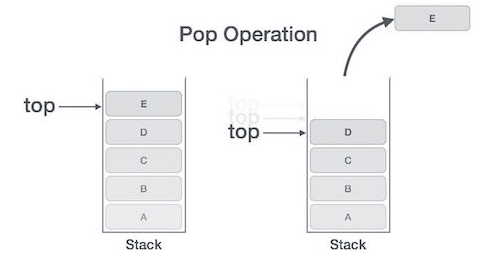
Algorithm for POP Operation
A simple algorithm for Pop operation can be derived as follows:
begin procedure pop: stack
if stack is empty
return null
endif
data ← stack[top]
top ← top - 1
return data
end procedure
Implementation of this algorithm in C, is as follows:
Example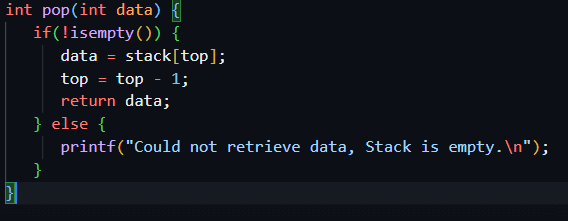
When data is PUSHed onto stack.
To use a stack efficiently, we need to check the status of stack as well. For the same purpose, the following functionality is added to stacks −
- peek(): get the top data element of the stack, without removing it.
- isFull(): check if stack is full.
- isEmpty(): check if stack is empty.
At all times, we maintain a pointer to the last PUSHed data on the stack. As this pointer always represents the top of the stack, hence named top. The top pointer provides top value of the stack without actually removing it.
First we should learn about procedures to support stack functions:
1. peek()
Algorithm of peek() function:
begin procedure peek
return stack[top]
end procedure
Implementation of peek() function in C programming language:
Example
2. isfull()
Algorithm of isfull() function:
begin procedure isfull
if top equals to MAXSIZE
return true
else
return false
endif
end procedure
Implementation of isfull() function in C programming language:
Example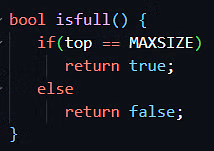
3. isempty()
Algorithm of isempty() function:
begin procedure isempty
if top less than 1
return true
else
return false
endif
end procedure
Implementation of isempty() function in C programming language is slightly different. We initialize top at -1, as the index in array starts from 0. So we check if the top is below zero or -1 to determine if the stack is empty. Here's the code −
Example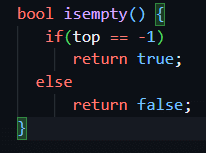
|
159 docs|30 tests
|
FAQs on Stacks Representation & Operations - Programming and Data Structures - Computer Science Engineering (CSE)
| 1. What is the representation of a stack? |  |
| 2. What is the algorithm for the PUSH operation in a stack? |  |
| 3. What is the algorithm for the POP operation in a stack? |  |
| 4. How can stacks be used in practical applications? |  |
| 5. What is the time complexity of the PUSH and POP operations in a stack? |  |




















